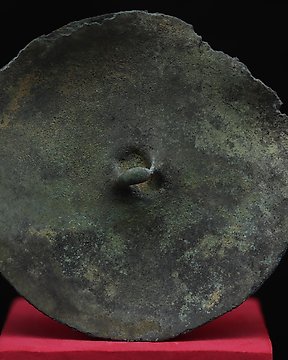
Età del Bronzo (Cultura del campo di urne) - Scudo votivo in bronzo - Reliquia - 8.7 cm (Senza Prezzo di Riserva)
N. 83745361

N. 83745361

Approximately 12th C BC - Late Bronze Age Europe (Urnfield culture)
Material: Bronze
Object: Socketed Axe-Head
Dimensions: 9.3 x 6.0 x 3.5 cm
Condition: Light-green patina, corrosion dissociated a smaller area of the socket
We guarantee originality.
Bronze Age axes were important tools and weapons that were used during the Bronze Age, a period characterized by the use of bronze, an alloy of copper and tin. The Bronze Age spanned different time periods in different regions, but in general, it occurred roughly between 3300 BCE and 1200 BCE in Europe. Bronze Age axes were made using this new metal technology and played a significant role in various aspects of society. Here's some information about Bronze Age axes:
Materials and Technology: Bronze Age axes were typically made from bronze, which was a significant advancement in metalworking compared to earlier periods when stone and copper were the primary materials used. The alloying of copper with tin (and sometimes other metals) created a stronger and more durable material suitable for tools and weapons.
Function: Bronze Age axes had both practical and symbolic uses. They were primarily used as tools for woodworking, clearing land, construction, and other tasks that required cutting or chopping. Some larger axes with more elaborate designs may have had ceremonial or ritual significance.
Types of Axes: There were several types of Bronze Age axes, each with distinct designs and purposes. These included:
Palstaves: These were flat, leaf-shaped axes with a flange or stopper at the top of the socket, preventing the axe from sliding down the handle. Palstaves were common during the Early Bronze Age.
Flanged Axes: Flanged axes had flanges on either side of the socket, which helped secure the axe head to the handle. They were prevalent during the Middle and Late Bronze Ages.
Socketed Axes: Socketed axes had a socket into which the wooden handle was inserted. These axes were often more elaborate in design and were widespread during the Late Bronze Age.
Decoration and Symbolism: Some Bronze Age axes were elaborately decorated with intricate patterns, geometric designs, or even representations of animals or human figures. These decorations could hold symbolic or cultural significance.
Archaeological Discoveries: Bronze Age axes have been discovered at various archaeological sites across Europe and other regions. They provide valuable insights into the technological advancements, craftsmanship, trade networks, and societal structures of the time.
Social Significance: The ownership and display of ornate or ceremonial axes may have held social or ceremonial importance, signifying the status or role of individuals within their communities.
Transition to Iron: The Bronze Age eventually gave way to the Iron Age, marked by the gradual adoption of iron tools and weapons due to its wider availability and superior properties. This transition led to significant changes in metalworking and technology.
Provenance: Property of a private collector from southern Germany, formed in the 1970s - 1980s.
The Seller can prove that the lot was obtained legally.
Important information. The seller guarantees that he is entitled to ship this lot.
The seller will take care that any necessary permits will be arranged.
The seller will inform the buyer about this if this takes more than a few days.
Come fare acquisti su Catawiki
1. Scopri oggetti speciali
2. Fai l’offerta più alta
3. Paga in tutta sicurezza